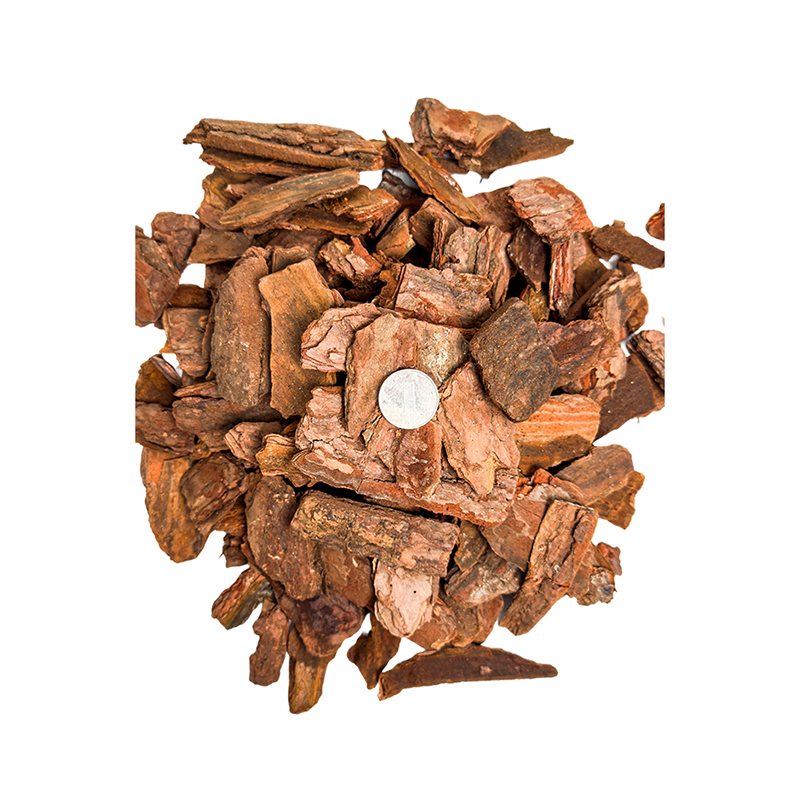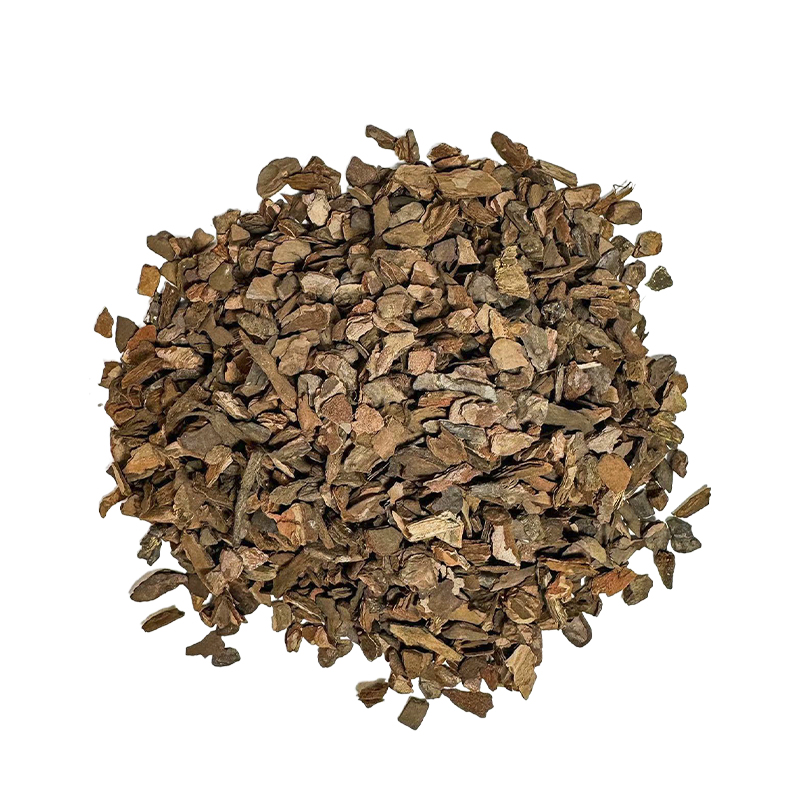What are the main benefits of using pine bark as an organic mulch?
Release Time : 2025-07-07
In modern landscaping and environmental management, choosing the right mulch material is of great significance for improving landscape effects, improving soil conditions, and reducing maintenance costs. As a high-quality organic mulch, pine bark has demonstrated its unique application value in biological deodorization fillers for sewage treatment plants, organic mulches for landscaping, and flower mirror decoration.
1. Original ecology and aesthetics
Pine bark comes from nature, retains the original texture and color of wood, and provides a rich visual layering for garden design. Whether it is laid beside the garden path or around the trees, pine bark can create an atmosphere close to nature, increasing the artistry and ornamental nature of greening. Especially in flower mirror decoration, pine bark fragments of different sizes and shapes can create a unique texture effect and enhance the design sense of the overall landscape.
2. Water-saving and fertilizer-retaining
Pine bark has good air permeability and moisture retention properties, which can effectively regulate soil moisture and reduce water evaporation. Studies have shown that after using pine bark as a covering layer, the soil moisture around the plant roots has increased significantly, thereby reducing the number of irrigations and saving water resources. In addition, nutrients are released during the slow decomposition of pine bark, which helps to improve soil fertility and promote plant growth.
3. Insulation effect
In winter, the pine bark covering layer can protect the soil from low temperatures like a "quilt" to prevent soil freezing; in summer, it can block direct sunlight from the ground, reduce the surface temperature, and prevent the soil from overheating. This temperature control effect is not only conducive to the healthy development of plant roots, but also prolongs the growth period of plants. It is particularly suitable for those plant planting areas that are sensitive to temperature.
4. Mosquito repellent and insect repellent
The natural resin components contained in pine bark have a certain insect repellent effect, especially for mosquitoes and other pests. Compared with chemical agents, the use of pine bark covering is both environmentally friendly and safe, will not cause harm to humans or pets, and can also effectively reduce the harm of pests to plants.
5. Inhibit weed growth
The pine bark covering layer can block sunlight and inhibit the light conditions required for weed seed germination, thereby achieving the purpose of inhibiting weed growth. This not only keeps the garden clean and beautiful, but also greatly reduces the workload of manual weeding and reduces the maintenance cost of greening projects.
6. Enhance greening effect
Due to its varying shades of color and natural form, pine bark can be well integrated into various greening environments, enhancing the overall beauty of greening areas. Especially in the construction of urban green spaces, the use of pine bark for ground covering can not only beautify the environment, but also play a role in dust absorption and noise reduction, and improve the ecological environment quality of the city.
7. Reduce project costs
Compared with traditional stone or plastic covering materials, pine bark is more affordable and easy to obtain. In addition, it does not require frequent replacement and has a long service life, which further reduces the cost of later maintenance. This is particularly important for large-scale greening projects, which can both ensure project quality and control budget expenditures.
8. Application in sewage treatment
The microbial community of pine bark contains specific types of bacteria, which can play an important role in the sewage treatment process. When applied to the biological deodorization system of the sewage treatment plant, pine bark can not only provide an ideal living environment for microorganisms, but also remove odor substances in the air through physical adsorption and biodegradation, significantly improving air quality.
In summary, as a multifunctional organic cover, pine bark has shown irreplaceable advantages in many fields. Whether it is used for water conservation and fertilizer conservation, heat preservation and weed control in landscaping, biological deodorization in sewage treatment plants, or aesthetic enhancement in flower mirror decoration, pine bark has won wide recognition for its outstanding performance. As people's understanding of the concept of green environmental protection continues to deepen, I believe that pine bark will play a more important role in future urban construction and environmental protection.
1. Original ecology and aesthetics
Pine bark comes from nature, retains the original texture and color of wood, and provides a rich visual layering for garden design. Whether it is laid beside the garden path or around the trees, pine bark can create an atmosphere close to nature, increasing the artistry and ornamental nature of greening. Especially in flower mirror decoration, pine bark fragments of different sizes and shapes can create a unique texture effect and enhance the design sense of the overall landscape.
2. Water-saving and fertilizer-retaining
Pine bark has good air permeability and moisture retention properties, which can effectively regulate soil moisture and reduce water evaporation. Studies have shown that after using pine bark as a covering layer, the soil moisture around the plant roots has increased significantly, thereby reducing the number of irrigations and saving water resources. In addition, nutrients are released during the slow decomposition of pine bark, which helps to improve soil fertility and promote plant growth.
3. Insulation effect
In winter, the pine bark covering layer can protect the soil from low temperatures like a "quilt" to prevent soil freezing; in summer, it can block direct sunlight from the ground, reduce the surface temperature, and prevent the soil from overheating. This temperature control effect is not only conducive to the healthy development of plant roots, but also prolongs the growth period of plants. It is particularly suitable for those plant planting areas that are sensitive to temperature.
4. Mosquito repellent and insect repellent
The natural resin components contained in pine bark have a certain insect repellent effect, especially for mosquitoes and other pests. Compared with chemical agents, the use of pine bark covering is both environmentally friendly and safe, will not cause harm to humans or pets, and can also effectively reduce the harm of pests to plants.
5. Inhibit weed growth
The pine bark covering layer can block sunlight and inhibit the light conditions required for weed seed germination, thereby achieving the purpose of inhibiting weed growth. This not only keeps the garden clean and beautiful, but also greatly reduces the workload of manual weeding and reduces the maintenance cost of greening projects.
6. Enhance greening effect
Due to its varying shades of color and natural form, pine bark can be well integrated into various greening environments, enhancing the overall beauty of greening areas. Especially in the construction of urban green spaces, the use of pine bark for ground covering can not only beautify the environment, but also play a role in dust absorption and noise reduction, and improve the ecological environment quality of the city.
7. Reduce project costs
Compared with traditional stone or plastic covering materials, pine bark is more affordable and easy to obtain. In addition, it does not require frequent replacement and has a long service life, which further reduces the cost of later maintenance. This is particularly important for large-scale greening projects, which can both ensure project quality and control budget expenditures.
8. Application in sewage treatment
The microbial community of pine bark contains specific types of bacteria, which can play an important role in the sewage treatment process. When applied to the biological deodorization system of the sewage treatment plant, pine bark can not only provide an ideal living environment for microorganisms, but also remove odor substances in the air through physical adsorption and biodegradation, significantly improving air quality.
In summary, as a multifunctional organic cover, pine bark has shown irreplaceable advantages in many fields. Whether it is used for water conservation and fertilizer conservation, heat preservation and weed control in landscaping, biological deodorization in sewage treatment plants, or aesthetic enhancement in flower mirror decoration, pine bark has won wide recognition for its outstanding performance. As people's understanding of the concept of green environmental protection continues to deepen, I believe that pine bark will play a more important role in future urban construction and environmental protection.







